In March of 2011, OCZ purchased SSD controller manufacturer Indilinx. Soon after the purchase, the two companies produced the OCZ Octane line of SSDs, powered by the Indilinx Everest controller.
This year, the Everest 2 controller debuted. It has made its way into the latest of OCZ’s major consumer products, this time powering the majority of the ‘4’ series. As its name would imply, the OCZ Vertex 4 is powered by this controller.
Everest 2 features
The Everest 2 controller combines a 400MHz dual-core CPU, SATA 6.0Gb/s interface, and supports a wide array of NAND—SLC, MLC, and TLC. SSD capacities up to 2TB are supported (the Vertex 4 is available in capacities up to 512GB). Eight NAND channels for up to 16-way interleaving per channel helps to increase read and write speeds.
Ndurance 2.0 is the technology suite designed to extend SSD life. These technologies focus mainly on two areas: reduction of physical wear and tear on the flash media, and improving SSD reliability through advanced error correction and data recovery capabilities.
HyperQueueing uses a proprietary algorithm to manage queued flash commands, which maximizes utilization of all available flash devices, and subsequently increases overall throughput.
Looking at the capacities available for the Vertex 4 and other Everest 2-based SSDs might lead you to believe there is no overprovisioning, but that would be incorrect. An OCZ representative stated there is a small amount of overprovisioning, but it is less than what other platforms require.
The Everest 2 controller eliminates the need for data compression, so performance remains roughly equal across data types. This is in contrast to controllers such as the SandForce 2200-series, which performs well with highly compressible data, but struggles when data is not easily compressed.
 Vertex 4 specs
Vertex 4 specs
- NAND Components: 2Xnm Synchronous Multi-Level Cell (MLC)
- Controller: Indilinx Everest 2
- DRAM Cache: up to 1GB
- MTBF: 2 million hours
- Encryption: 256-bit AES, ATA Security Mode features
- Power consumption: 1.3W idle, 2.5W active
The specs for the Vertex 4 have changed recently for all models except the 64GB version. As of firmware version v1.4 (the current version that came with the review sample is v1.5), the performance specs are as follows:
| Performance | 64GB | 128GB | 256GB | 512GB |
|---|---|---|---|---|
| Sequential Reads | 460MB/s | 560MB/s | 560MB/s | 560MB/s |
| Sequential Writes | 220MB/s | 430MB/s | 510MB/s | 510MB/s |
| Random 4k Read IOPS | 70,000 IOPS | 90,000 IOPS | 90,000 IOPS | 95,000 IOPS |
| Random 4k Write IOPS | 50,000 IOPS | 85,000 IOPS | 85,000 IOPS | 85,000 IOPS |
| Maximum IOPS | 85,000 IOPS | 120,000 IOPS | 120,000 IOPS | 120,000 IOPS |
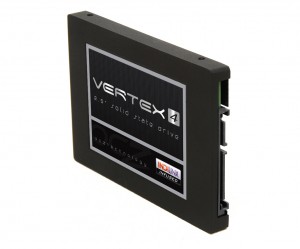 What happened to boost performance enough that a spec update was warranted? After gathering usage data patterns from selected test case customers, as well as internal testing, there were trends that repeatedly surfaced. One of these trends is that SSDs generally have a large percentage of unused space due to use as either a boot drive, hot data cache, or as storage for performance-oriented applications. With the v1.4 update, Vertex 4 SSDs that are at less than 50% capacity will see increased performance thanks to a particular series of optimizations—the larger amount of unused space is more easily and quickly rotated into use when additional space is needed. Once the 50% capacity threshhold is reached, the garbage collection algorithms will re-optimize the drive for maximum efficiency based on the larger data footprint. During the transition there may be a small and brief latency hit, but this is a one-time event, and performance will quickly improve again once the drive is optimized for the larger storage amount.
What happened to boost performance enough that a spec update was warranted? After gathering usage data patterns from selected test case customers, as well as internal testing, there were trends that repeatedly surfaced. One of these trends is that SSDs generally have a large percentage of unused space due to use as either a boot drive, hot data cache, or as storage for performance-oriented applications. With the v1.4 update, Vertex 4 SSDs that are at less than 50% capacity will see increased performance thanks to a particular series of optimizations—the larger amount of unused space is more easily and quickly rotated into use when additional space is needed. Once the 50% capacity threshhold is reached, the garbage collection algorithms will re-optimize the drive for maximum efficiency based on the larger data footprint. During the transition there may be a small and brief latency hit, but this is a one-time event, and performance will quickly improve again once the drive is optimized for the larger storage amount.
Also of note is the warranty for the Vertex 4. Where most SSDs come with a three year warranty period, OCZ offers a five year warranty on the Vertex 4.
Does Everest 2 mean we won’t see any more SandForce-powered OCZ drives anymore? It isn’t an absolute certainty; it is still possible that some next-gen products will still use SandForce controllers. My guess is that there will be a couple more products from the company powered by SandForce, but the overwhelming majority of hardware from here on out will feature Indilinx controllers.
Performance
Atto
Crystal DiskMark
AS-SSD
Anvil
Where reading highly compressible data is concerned, the Vertex 4 isn’t quite as strong as the Vertex 3. Writing the same kind of data is pretty much equal across all data transfer sizes. Move to incompressible data and the situation changes a bit, with the Vertex 4 matching or exceeding the Vertex 3’s read speeds and regularly exceeding its write speeds, sometimes by a huge margin.
But there’s something else to consider: Everest 2’s performance remains consistent regardless of data compressibility. Highly compressible data is something Sandforce controllers have historically struggled with—4K data especially. Looking at the Anvil 4K non-queued read results, the Everest 2-powered Vertex 4 is nearly as fast as the Sandforce-powered Vertex 3.
Why do I point this out? The vast majority of reads and writes for most desktop and laptop systems are 4K, non-queued, random operations. With these reads, the Vertex 4 performs very well—almost as well as the Vertex 3. 4K writes heavily favor the Vertex 4, in some cases by a large margin. In rare cases, a queue depth as high as four could be reached, but even under these conditions, the Vertex 4’s performance far surpasses the Vertex 3.
Conclusion
 The Vertex 4 is a consistent performer across all data types, and when it comes down to the most common data and operation types, that consistent performance tends to be better than its predecessor.
The Vertex 4 is a consistent performer across all data types, and when it comes down to the most common data and operation types, that consistent performance tends to be better than its predecessor.
The Vertex 4 256GB SSD sells for $209.99 on Newegg. SSD prices have finally fallen below the $1/GB mark, and it’s a welcome change. While older drives of similar capacity are slightly less expensive (the Vertex 3 240GB is currently on sale for $189.99), the performance advantage of the Vertex 4 certainly must be weighed against the cost difference.
All things considered, when choosing between the Vertex 4 and Vertex 3, I’d take the Vertex 4. Its performance across data types is high as well as consistent, and this fact alone outweighs the small price premium that the Vertex 4 brings to the table. The Vertex 4 is another solid performer from OCZ and we’re happy to award this drive the Icrontic Stamp of Approval as a drive we’d recommend to people building a new system or upgrading an older system with SATA 6.0Gb/s support.


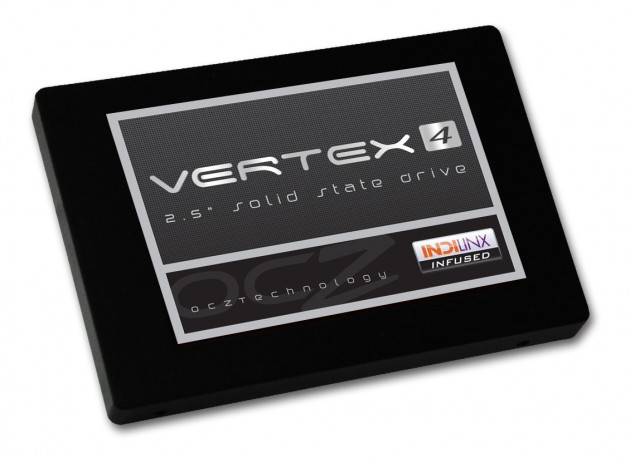
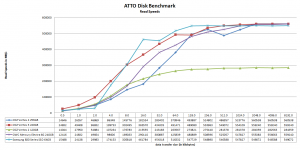
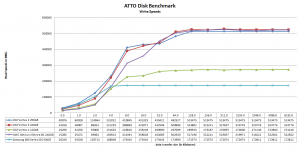
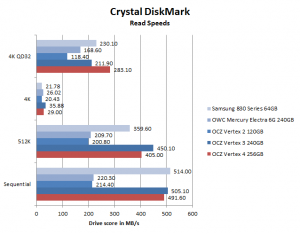
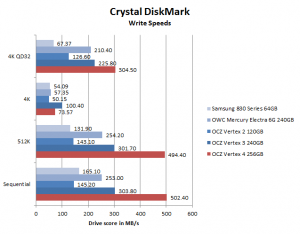
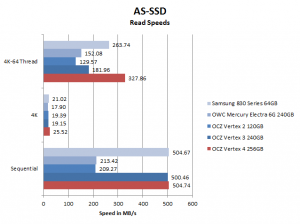
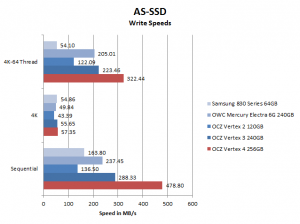
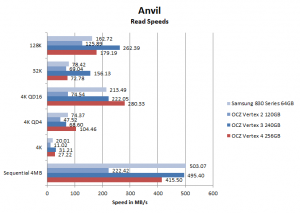
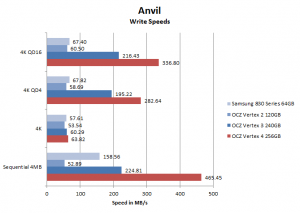
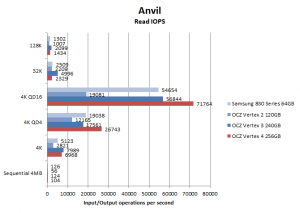
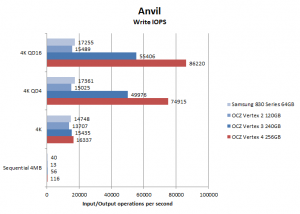



 Articles RSS
Articles RSS